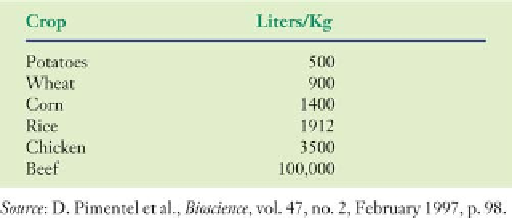Geography Reference
In-Depth Information
States in 2005. The coast endured the loss of XX lives
and $XX in damages.
TABLE 13.1
Estimated Liters of Water Required to Produce
1 Kilogram of Food
Patterns of Consumption
We humans rely on Earth's resources for our very sur-
vival. At the most basic level, we consume water, oxygen,
and organic and mineral materials. Over time we have
developed increasingly complex ways of using resources
in pursuit of agricultural intensifi cation and industrial
production. Consequently, many societies now consume
resources at a level and rate that far exceed basic subsis-
tence needs. In a 1996 article on “Humanity's Resources”
in
The Companion Encyclopedia of Geography:
The
Environment and Humankind
, I. G. Simmons notes that
a hunter-gatherer could subsist on the resources found
within an area of about 26 square kilometers, whereas
today many people living in urban centers in the global
economic core have access to resources from all over the
planet.
Generally, the smaller numbers of people in the parts
of the world belonging to the global economic core make
far greater demands on Earth's resources than do the
much larger numbers in the poorer countries. It has been
estimated that a baby born in the United States during the
fi rst decade of the twenty-fi rst century, at current rates,
consumes about 250 times as much energy over a lifetime
as a baby born in Bangladesh over the same lifetime. In
terms of food, housing, and its components, metals, paper
(and thus trees), and many other materials, the consump-
tion of individuals in affl uent countries far exceeds that
of people in poorer countries. Thus, rapid population
growth in the periphery tends to have local or regional
environmental impacts. Population growth in the core is
also a matter of concern, one whose impact is not just local
or regional but global.
The foregoing discussion underscores the importance
of thinking geographically about human impacts on the
natural world. People living in the global economic periph-
ery tend to affect their immediate environment, putting
pressure on soil, natural vegetation, and water supplies, and
polluting the local air with the smoke from their fi res. The
reach of affl uent societies is much greater. The demand for
low-cost meat for hamburgers in the United States has led
to deforestation in Central and South America to make way
for pastures and cattle herds. In the process, water demand
has increased in such areas (Table 13.1). This example
shows just one of the many ways in which the American
(and European, Japanese, and Australian) consumer has an
impact on distant environments.
Globally, consumption is tied to technology, for (as
we saw in Chapter 12) the industrialized core has access to
a vast array of transportation and communication technol-
ogies that allow advertisers to stimulate demand for par-
ticular goods around the world and allow manufacturers
to bring goods from distant places. The growth of wealth
over the last ten years in the semi-periphery, including
India and China, and their growing middle and upper
classes, has increased the global consumption of con-
sumer goods. For example, in 2008 the Indian company
Tata (which we talked about at the beginning of Chapter
4) created the Nano, an automobile for the Indian market
that is priced below $2500. Tata plans to produce 250,000
Nano cars a year.
Technological developments have expanded the pro-
duction of consumer goods. Those same developments have
allowed humans to manipulate atmospheric, land, oceanic,
and biological systems in profound ways. Understanding
the complex ties between technology and environmental
change requires consideration of several different facets of
the technology picture.
Industrial Technology
Technological advances have increased rapidly since the
Industrial Revolution and today affect all aspects of our
lives. We are continually developing technologies that
we hope will improve our standard of living, protect us
against disease, and allow us to work more effi ciently.
These technologies come with a cost. Resource extrac-
tion practices such as mining and logging, which provide
the materials to produce technologies, have created severe
environmental problems. Technological innovations have
produced hazardous and toxic by-products, creating pol-
lution and health problems that we are only now begin-
ning to recognize. Most signifi cant for our discussion of
global environmental change, however, is the fact that
technology has enabled humans to alter large portions of
the planet in a short period of time.
There are many dramatic examples of the role of
industrial technology in environmental change. The
impacts include degradation of the oceans (oil and gas
exploitation and spills, pollution dumping, and massive
overfi shing), land surfaces (open pit and mountain top











































